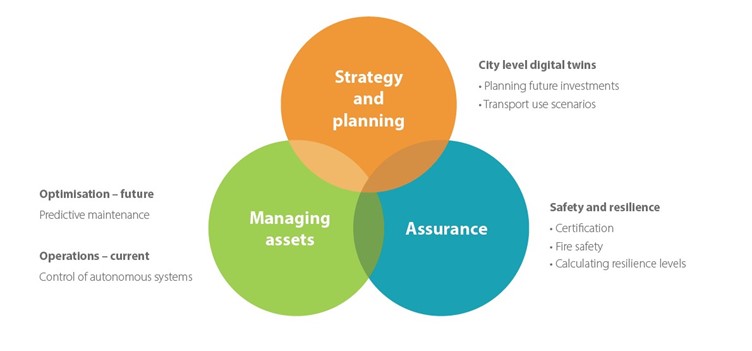As an industry leader in the AECO sector, you are always looking for ways to drive innovation and improve efficiency in your organisation. One technology that is gaining traction and making a real impact is the Digital Twin (DT). This blog post will explore the business case for implementing a Digital Twin, including the benefits it can bring to your organisation. A Digital Twin can majorly impact your operations by improving decision-making and reducing costs. If you are interested in learning more about how your company can benefit from this powerful technology, read on!
Common Definitions
A Business Case is a document that outlines the rationale and potential benefits of a proposed project or action. It persuades stakeholders to invest in the project and supports its implementation.
A Digital Twin is a realistic digital representation of assets, processes, or systems in the built or natural environment used in various industries, such as manufacturing, healthcare, transportation etc.
Background
A Digital twin offers immense opportunities. It allows for exploring different scenarios and testing proposed technological, process, or strategy changes. Digital twins can also be used to streamline business operations and simulate prototypes, cutting down on wasted time, money, and effort. However, effective business planning is important for gaining support and raising capital for Digital Twin initiatives. Writing a business case provides an opportunity to justify and evaluate the need for a Digital Twin.
Use Cases
In order to effectively justify the need for developing a business case for a digital twin, its important to understand its purpose and the use it is being developed for. This Use Case Framework presents three distinct high level use case areas; Strategy and Planning, Managing Assets and Assurance.
Strategy and Planning
Digital Twins can inform a government policy, an organisation’s strategy, or a plan to construct new assets. For example, a local authority might use a Digital Twin of a region to inform decisions on new housing developments and infrastructure. Private companies may also use Digital Twins to inform decisions, such as when considering a merger. These Digital Twins support multi-criteria decision-making, allowing for exploring trade-offs and optimal choices.
Managing Assets
Digital Twins can be used to improve the performance, availability, and safety of assets, processes, and enterprises. These Digital Twins consider how assets are used and degraded over their lifespan, supporting maintenance, repair, and overhaul decisions. They can also be used to support ‘capital versus operating’ expenditure decisions, balancing cost, and future revenue.
Assurance
Digital Twins can be used to provide assurance for the safety and resilience of assets, processes, and systems. These Digital Twins often rely on physical models and probabilistic methods to forecast behaviour with high certainty. The forecasting window can be months, years, or decades, with certainty decreasing over time. This use case is important in periods of significant technological, social, and environmental change and when seeking life extension for high-value assets used in critical applications.
Guidance
The HM Treasury Green Book provides guidance on developing an effective business case for a project. This guidance is considered good practice for all projects but is mandatory in certain situations, such as the introduction of new public assets or services, significant changes to existing assets or services, or a need to re-evaluate the delivery model of an existing asset or service. The guidance covers five key elements: the strategic case, economic case, commercial case, financial case, and management case. These elements support the development of a holistic and compelling business case and help the owner to systematically consider and present the impact of new technology.
In addition to this model, the “desirability, feasibility, viability” approach can be used to frame the need for a Digital Twin and quantify the value for money when justifying its investment, where desirability covers the use cases and reasons for change, feasibility covers financial, and management considerations and viability covers socio-economic and commercial factors.
Questions and Considerations for a DT Roadmap
Why do we need a DT?
- Organisation’s overall digital strategy and level of Information maturity
- Cultural acceptance
- Business/customer/supply chain readiness
What is the DT for?
- Problem Statement
- Potential Use Cases
- Internal and External Stakeholders
- High-level Information Requirements
What type of DT do we need?
- Type of DT needed: descriptive, informative, predictive etc.
- Level of Complexity
Can we go ahead with the DT?
- Business case and Continuous Business Justification
- Organisational buy-in and approval
How are we going to build the DT?
- Project plans
- Critical Success Factors
- KPIs and Key Metrics
What information do we need?
- Information that will be used in the decision-making process
- Critical components of the real system that are necessary for the interventions to be successful
- Standardisation of different model datasets to a common format for ease of use
What data do we have?
- Sources of data (external/internal, closed/open, direct/inferred)
- Quality of data, including its standardisation, interoperability, and reliability
- Tools and techniques to monitor the activity and operating environment, e.g. periodic inspections (IoT) sensors.
Who will do what?
- Roles and Responsibilities
- Data ownership & Access Rights
- Liabilities
What does the model look like?
- Overall design and architecture of the model
- Information required to train-test, and validate the model to accurately represent the real system
What does the data tell us?
- Data analysis to identify patterns, gain insights and understand the behaviour of the real system.
- Predictive analytics and What-if Scenarios to improve accuracy and reliability, forecast future behaviour and explore different potential outcomes
- Automation to support faster data-driven decision making
How are we doing?
- Specific performance and condition metrics that will be used to evaluate the effectiveness and efficiency of the interventions
What interventions should we make?
- System performance and Operational Behaviour
- Decisions based on the output of the digital twin
- Continuous Improvement adjustments to maximise use-life
Conclusion
If you would like more information on the Digital Twins, get in touch!
You can email us at info@logikalprojects.com
Or call on +44 (0)20 7404 4826 (UK & Europe) or +61 1300 564 452 (APAC)
Or you can use the Contact Us form here.







